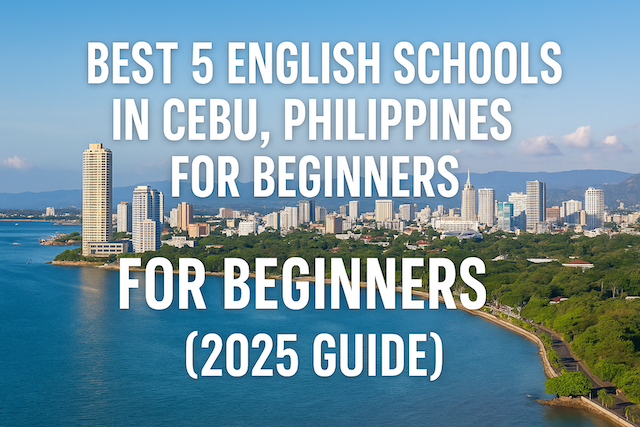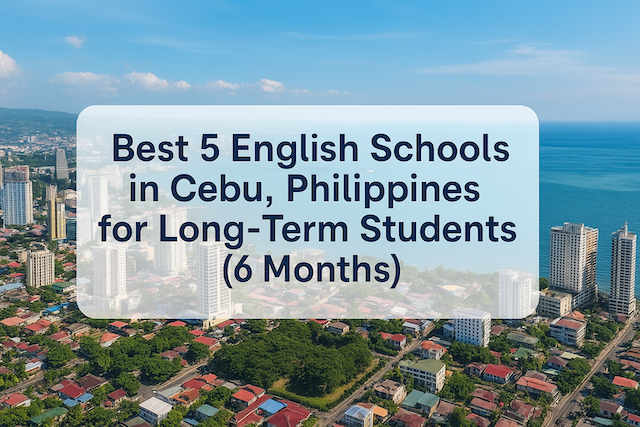The Rise of English Schools in the Philippines: A 2025 Market Report
Contents
- 1 The Rise of English Schools in the Philippines: A 2025 Market Report
- 2 1. A Brief History of ESL in the Philippines
- 3 2. Key Locations: Cebu, Baguio, Clark, and Beyond
- 4 3. Types of ESL Programs and Price Ranges
- 5 4. Why the Philippines Is Leading the Global ESL Market
- 6 5. Cebu as the Heart of ESL in the Philippines
- 7 6. The Economic Impact of ESL Schools in 2025
- 8 7. Challenges and Opportunities Moving Forward
- 9 8. Case Study: The Growth of Schools Like CIA & Pines Group
- 10 9. Conclusion: The Philippines in the Global ESL Future
The Rise of English Schools in the Philippines: A 2025 Market Report
Introduction: Why the Philippines Has Become the ESL Capital of Asia
In the past two decades, the Philippines has transformed from a hidden gem into a global powerhouse in the English as a Second Language (ESL) industry. Once overshadowed by more traditional destinations like the UK, USA, and Australia, the country is now recognized as the most accessible, affordable, and immersive destination for English learners—particularly from Asia, the Middle East, and Latin America.
As of 2025, the ESL industry in the Philippines is not just growing—it’s thriving. With hundreds of accredited language schools across key cities like Cebu, Baguio, and Clark, and with a teaching force composed of fluent, neutral-accented Filipinos, the nation has become the #1 alternative to native-English countries. Lower tuition fees, tropical island environments, and cultural compatibility make the Philippines a smart choice for learners of all backgrounds—students, professionals, retirees, and even families.
This market report dives into the numbers, trends, and future outlook of this booming industry. Whether you’re a prospective student, a partner agency, or a language school operator, this comprehensive guide will help you understand why now is the best time to look to the Philippines for English education.
1. A Brief History of ESL in the Philippines
The rise of English education in the Philippines is no accident—it is rooted in the country’s unique colonial history, cultural dynamics, and global positioning.
American Colonial Legacy and Early English Adoption
The Philippines’ deep connection to the English language began in the early 1900s during the American colonial period. Unlike many other Asian nations, English was introduced not as a foreign language, but as a medium of instruction in public schools. By the time the Philippines gained independence in 1946, English had already become a second national language.
This early adoption set the foundation for the country’s English fluency, literacy rates, and global readiness.
Call Center Boom and the Rise of the BPO Sector
In the 2000s, the global Business Process Outsourcing (BPO) boom placed the Philippines on the map for its “neutral” English accent, polite communication style, and cost-effective labor. Major companies outsourced call centers and back-office functions to Filipino professionals—raising the country’s profile as a destination for English-based services.
This same infrastructure—fast internet, skilled workforce, and English-speaking environment—paved the way for the growth of English language schools.
The Korean Wave: Birth of the Modern ESL Industry
The modern ESL industry in the Philippines truly began in the early 2000s with an influx of Korean students. Attracted by affordable prices, cultural proximity, and 1-on-1 teaching styles, thousands of young Koreans began enrolling in Cebu, Baguio, and Clark. They were soon followed by Japanese, Taiwanese, Vietnamese, and Thai learners.
This first wave solidified the Philippines as a go-to destination for intensive English immersion at a fraction of Western prices.
Expansion into New Markets (2010–2020)
Throughout the 2010s, the ESL sector expanded its reach. Schools diversified programs to include IELTS, TOEFL, business English, and junior camps. New student markets such as the Middle East, Russia, Brazil, and Mongolia started to emerge. Schools also began offering online lessons to meet off-shore demand.
Even COVID-19, though disruptive, catalyzed a shift toward online ESL models—further proving the industry’s adaptability.
2025 and Beyond
Now in 2025, the Philippines stands as Asia’s ESL capital, serving tens of thousands of students each year. The country’s mix of history, affordability, native-level fluency, and tropical lifestyle makes it not just a budget option—but a smart, strategic choice.
In the next section, we’ll explore the top locations where this ESL boom continues to thrive.
2. Key Locations: Cebu, Baguio, Clark, and Beyond
The success of English education in the Philippines is not just nationwide—it is geographically concentrated in a few powerhouse cities, each offering distinct advantages for international students.
Cebu: The Island City with Global Appeal
Cebu, often referred to as the “Queen City of the South,” has become the most popular destination for ESL learners in the Philippines. What sets Cebu apart?
-
Resort lifestyle meets study environment – Students can enjoy world-class beaches and urban convenience.
-
Diverse student population – Koreans, Japanese, Taiwanese, Arabs, and Russians flock to Cebu.
-
Wide range of schools – From budget to premium, with specialized programs (IELTS, Business, Junior Camps).
-
International airport access – Direct flights to Korea, Japan, Taiwan, Singapore, and more.
Cebu offers a balance of learning and leisure that’s hard to beat.
Baguio: The “Summer Capital” Turned Study Hub
Known for its cool climate and mountainous scenery, Baguio became the birthplace of premium ESL education in the 2000s. Key features include:
-
Academic-focused atmosphere – Ideal for serious learners who want fewer distractions.
-
Affordable cost of living – Budget-friendly for long-term study.
-
Well-established schools – Many of the top Korean-owned academies originated here.
Baguio remains a favorite for students seeking a quieter, more intensive study experience.
Clark & Subic: Rising Alternatives with Strategic Access
These former U.S. military bases have transformed into special economic zones with English schools, golf resorts, and casinos.
-
Proximity to Manila – Just 1–2 hours away, but less congested.
-
Premium ESL campuses – Large facilities with dorms, sports, and amenities.
-
Appeals to older students and professionals – Often hosts business English and TOEIC-focused learners.
Clark is gaining traction for students who want convenience without the chaos of big cities.
Other Emerging Hubs: Bacolod, Davao, Iloilo
In recent years, more ESL schools have opened in secondary cities. These areas offer:
-
Lower cost of living
-
Less competition for part-time jobs
-
Unique cultural experiences
While still developing, they reflect the growing demand and decentralization of ESL in the country.
3. Types of ESL Programs and Price Ranges
The Philippines offers one of the most diverse and cost-effective ESL program ecosystems in the world. Whether you’re a beginner, a business executive, a student preparing for IELTS, or a parent planning a family study program, there’s something tailored for you.
General ESL Programs (Beginner to Intermediate)
These are the most common offerings and typically include:
-
4–6 hours of 1:1 classes per day
-
Optional group classes (conversation, grammar, pronunciation)
-
Daily vocabulary tests, homework, and coaching
-
Target audience: All levels, especially beginners
💡 Estimated cost:
$1,000–$1,800/month (including tuition, dormitory, meals, and utilities)
Intensive ESL Programs (Accelerated Learning)
Designed for students who want faster results:
-
6–8 hours of instruction per day
-
More 1:1 classes, less downtime
-
Sometimes includes Saturday review sessions
-
Target audience: Motivated learners or short-term students
💡 Estimated cost:
$1,100–$1,900/month
IELTS, TOEIC, and TOEFL Prep Courses
These specialized programs are for students aiming to pass international exams:
-
Expert instructors with testing experience
-
Weekly mock exams and performance tracking
-
Test registration and official centers often on-site
-
Target audience: Students planning to work or study abroad
💡 Estimated cost:
$1,200–$2,000/month
Business English Courses
For professionals seeking communication skills in global contexts:
-
Presentation, negotiation, and meeting skills
-
Customized curriculum based on industry
-
Sometimes include on-site company visits or practical simulations
💡 Estimated cost:
$1,200–$2,000/month
Junior and Family Programs
These are growing in popularity, especially during vacation months:
-
Kids and teens get ESL lessons, parents study or accompany
-
Camps with excursions, meals, and 24/7 support
-
Ideal for summer or winter breaks
💡 Estimated cost:
$1,000–$1,800/month per person
(Discounts often apply for family packages)
Premium and Semi-Spartan Programs
Some academies offer luxury dorms, swimming pools, gyms, and ocean views; others enforce strict rules and study schedules:
-
Choose based on lifestyle preferences and discipline needs
-
Premium = comfort + flexibility
-
Spartan = results + structure
The pricing varies, but compared to countries like the USA, UK, or Australia, students often save 50–70% in total costs, including accommodation and food.
4. Why the Philippines Is Leading the Global ESL Market
The Philippines has firmly established itself as a top global destination for ESL education, and the reasons go far beyond affordability. Let’s explore the key factors that have propelled the country to the forefront of the English education industry.
🇵🇭 1. English as an Official Language
Unlike many other low-cost study destinations, the Philippines has English as one of its official languages. It is used in government, media, education, and business. As a result, students are immersed in an English-speaking environment both in and outside the classroom.
🧑🏫 2. One-on-One Class System
This is the Philippines’ unique advantage. Schools offer 4–7 hours of 1:1 instruction daily, tailored to each student’s pace and goals. This is rarely found elsewhere, where classes are often group-based with minimal personal attention.
👩🏫 3. High-Quality, Friendly Teachers
Most Filipino ESL teachers:
-
Hold education or English degrees
-
Are TESOL- or CELTA-certified
-
Speak clear, neutral-accent English
-
Are known for their warmth and patience
This combination creates a comfortable and effective learning environment, especially for beginners.
💰 4. Excellent Cost-Performance
Compared to traditional study destinations, students in the Philippines enjoy:
-
Lower tuition fees
-
Affordable cost of living
-
On-campus meals and dormitories
-
Lower visa and travel costs
💡 Example: A month in Cebu might cost $1,200 all-inclusive, while a similar experience in Canada may cost $3,000–$4,000.
✈️ 5. Location, Accessibility, and Lifestyle
With direct flights from across Asia, tropical weather, and island life, students enjoy:
-
Weekend getaways to world-class beaches
-
Cultural exposure to both Western and Asian influences
-
A relatively safe, relaxed lifestyle
This balance of education and leisure is ideal for long-term learning.
🌐 6. Growing International Diversity
In 2025, ESL schools in the Philippines now serve students from:
-
Japan, Korea, Taiwan
-
Vietnam, Thailand, Mongolia
-
Saudi Arabia, Turkey, Brazil
-
Russia, France, and beyond
This multicultural mix enhances the learning experience and global exposure.
5. Cebu as the Heart of ESL in the Philippines
Among all the ESL destinations in the Philippines, Cebu City stands out as the most dynamic and strategic hub for English language learners. Here’s why:
🏙️ A Safe, Student-Friendly Urban Environment
Cebu combines the convenience of a modern city with the safety and warmth of a small town. It offers:
-
A large number of reputable ESL schools
-
A welcoming and relatively low-crime environment
-
Friendly locals accustomed to foreign visitors
This makes it especially appealing for first-time international students.
✈️ Accessibility from Across Asia
With Mactan-Cebu International Airport serving direct flights from major Asian cities like Tokyo, Seoul, Taipei, Hong Kong, and Singapore, Cebu is:
-
Easier to reach than Manila
-
Less crowded and more relaxed
This convenience is a big plus for short- and long-term learners alike.
🏖️ Balance of Study and Leisure
Cebu offers a perfect mix of study and lifestyle:
-
Weekday focus on English learning
-
Weekend trips to tropical beaches like Moalboal, Bantayan, or Bohol
-
Island hopping, snorkeling, scuba diving, and more
Students can refresh and recharge while maintaining study momentum.
🏫 A Wide Variety of ESL Programs
Cebu is home to dozens of schools offering:
-
General ESL, IELTS, TOEIC, Business English, and Kids’ courses
-
Dormitory options, private apartments, or hotel-based study packages
-
Diverse teaching styles catering to different goals and backgrounds
Whether you’re a beginner or aiming for IELTS 7.5, there’s a program tailored to you.
💬 Multicultural Student Community
Cebu’s ESL population is one of the most diverse in the country. In 2025, many schools host learners from over 20 nationalities, creating:
-
A global classroom experience
-
Opportunities for intercultural exchange
-
Lifelong international friendships
This diversity also fosters more practical, global communication skills.
🌱 Growth and Innovation in ESL Education
Many of the most innovative ESL models—such as 1:1 intensive training, customized visa-friendly packages, and hybrid online-offline learning—originated in Cebu.
Cebu continues to be the testing ground for new ideas, making it the beating heart of ESL education in Southeast Asia.
6. The Economic Impact of ESL Schools in 2025
The ESL (English as a Second Language) industry in the Philippines is not just an educational sector—it’s a powerful economic driver, particularly in 2025 as international travel continues to normalize post-pandemic. Here’s how the ESL boom is shaping the Philippine economy today:
💼 Job Creation Nationwide
ESL schools generate thousands of jobs directly and indirectly, including:
-
English teachers and academic staff
-
Support personnel: cleaners, chefs, security guards, and drivers
-
Marketing & administrative professionals
-
IT and content creators (online ESL platforms, video, curriculum)
In major ESL hubs like Cebu, Baguio, and Clark, entire communities benefit economically.
🏢 Stimulating the Local Real Estate Market
The demand for ESL facilities has led to:
-
Construction of dedicated school campuses and dormitories
-
Increased demand for rental condos and serviced apartments
-
Growth of student-oriented neighborhoods near malls and transport hubs
In 2025, many developers are designing “study-tourism-friendly” properties tailored for ESL students.
✈️ Boosting Tourism and Travel Services
Each year, tens of thousands of students bring family and friends to the Philippines for short visits. This leads to:
-
Bookings at hotels, resorts, and day tours
-
Increased demand for transportation, such as taxis and domestic flights
-
Higher spending at restaurants, souvenir shops, and malls
In effect, ESL learners serve as long-term, steady tourists.
📈 A Resilient Export Service
English education is considered a form of “invisible export”—foreign students pay in USD, JPY, KRW, etc., but the income flows directly into the Philippine economy.
In 2025:
-
The ESL industry contributes hundreds of millions of dollars annually
-
It ranks alongside BPOs and OFW remittances in impact
-
It has proven resilient, rebounding faster than many other sectors
🤝 Foreign Partnerships and Global Reputation
Top schools are partnering with institutions in:
-
Japan, South Korea, Taiwan, Vietnam, and Saudi Arabia
-
Universities offering credit programs or exchange pathways
-
Immigration services promoting “English + Migration” packages
These relationships further elevate the Philippines’ global educational reputation.
7. Challenges and Opportunities Moving Forward
Despite the growing success of the ESL industry in the Philippines, 2025 presents a unique set of challenges and opportunities. Schools, policymakers, and communities must adapt to stay competitive and relevant in the global education market.
⚠️ Challenges
1. Intensifying Global Competition
Other countries like Malaysia, Vietnam, and Bali are rapidly investing in their ESL sectors, offering similar price points and tropical settings.
Solution: The Philippines must focus on its native English proficiency, immersive culture, and 1:1 learning model as key differentiators.
2. Visa and Immigration Policies
Students often face confusion around visa extensions, ACR-I card requirements, and unclear guidelines.
Solution: Simplifying immigration rules and offering student-friendly visa pathways (like SRRV for long-term learners) will make the country more attractive.
3. Quality Control and Accreditation
Not all ESL schools operate with the same standards. Subpar institutions hurt the industry’s image.
Solution: Implementing a stronger national accreditation system, possibly with international oversight, would ensure consistent quality.
4. Teacher Retention and Development
High turnover and lack of training can affect learning quality.
Solution: Schools must invest in ongoing teacher development, better compensation, and long-term career growth paths.
✅ Opportunities
1. Expansion into Online and Hybrid Models
COVID-19 accelerated digital learning. Even in 2025, there’s growing demand for hybrid ESL options that combine in-person learning with online prep or follow-up.
2. Niche Markets: Seniors, Families, and Digital Nomads
The ESL industry can grow by targeting non-traditional demographics:
-
Senior learners seeking slow-paced programs with wellness
-
Family study packages offering ESL for both parents and children
-
Digital nomads looking to study and work remotely
3. Linking ESL to Migration Pathways
Many students study English as a stepping stone to immigration (e.g., Canada, Australia). Schools that combine ESL with IELTS or pathway programs will be in high demand.
4. Private-Public Collaboration
If government agencies (like DOT or TESDA) work closely with ESL schools, they can promote the Philippines as the premier ESL destination in Asia through national campaigns.
8. Case Study: The Growth of Schools Like CIA & Pines Group
The rise of ESL schools in the Philippines isn’t just about numbers—it’s about strategic evolution, location shifts, and brand reinvention. Two of the most prominent success stories in recent years are CIA (Cebu International Academy) and Pines International Academy / Blue Ocean Group.
🏫 CIA (Cebu International Academy): Strategic Relocation & Rebranding
Background:
Originally located in Mandaue City, CIA had long been known as a top-tier IELTS-focused ESL school in Cebu. However, its former campus was becoming outdated, and nearby competitors were modernizing.
The Move:
In 2022, CIA relocated to a brand-new resort-style campus near Mactan Newtown, closer to the airport and the beach. This strategic move reshaped its brand perception.
Key Success Factors:
-
✅ Resort-like campus: Modern dormitories, gym, pool, and open-air dining appealed to Korean, Japanese, and Middle Eastern students.
-
✅ Brand repositioning: The new location allowed CIA to market itself as a premium ESL destination, not just a school.
-
✅ Focus on IELTS & Professionals: CIA leveraged its longstanding IELTS expertise and catered to adult learners seeking exam-focused or professional English training.
Result:
The relocation led to a 200–300% increase in enrollment within a year, expanded its market beyond East Asia, and helped it weather post-pandemic shifts better than most.
🌄 Pines Group & Blue Ocean: Dual-City Strategy in Baguio and Cebu
Background:
Pines International Academy is one of Baguio’s most respected ESL institutions, with a long history of academic rigor and structured curriculum. In 2015, it launched Blue Ocean Academy in Cebu, targeting a different segment of the market.
Dual-City Model:
-
Baguio (Pines): Highland city with cooler climate, strict English-only policy, and intensive study programs.
-
Cebu (Blue Ocean): Coastal, resort-style setting with more relaxed, lifestyle-oriented programs.
Strategic Approach:
-
🔁 Internal Transfers: Students can start in Baguio for intensive foundation, then shift to Cebu for practical speaking or test prep in a more relaxed environment.
-
🌍 Diverse Marketing: Pines markets Baguio to serious Korean, Japanese, and Chinese learners, while Blue Ocean attracts Middle Eastern, Taiwanese, and Southeast Asian students looking for balance.
-
🧩 Curriculum Sync: Shared academic management ensures consistency between campuses.
Results:
-
💡 Cross-regional dominance: Pines is now synonymous with “serious study” in Baguio, while Blue Ocean leads in “semi-intensive + lifestyle” in Cebu.
-
📈 Scalable Model: Their dual-location model serves as a blueprint for other schools exploring multi-campus expansion.
📝 Takeaway Lessons for Other ESL Schools:
-
Location matters—but brand experience matters more. CIA succeeded not just by moving, but by transforming the student experience.
-
Dual-campus strategies work—if supported by a strong academic backbone. Pines & Blue Ocean show that one brand can serve multiple learner personas if executed thoughtfully.
-
Adaptability is the new currency. Post-COVID trends require schools to be flexible in delivery, demographics, and even geography.
9. Conclusion: The Philippines in the Global ESL Future
As we look ahead to the evolving landscape of English language education, one thing is clear: the Philippines will remain a dominant force in the global ESL market.
With a unique blend of affordability, cultural warmth, and a high standard of English instruction, the country has carved out a niche that larger, more expensive markets cannot easily replicate. More importantly, the industry continues to evolve—not just in scale, but in sophistication.
From modern campus relocations like CIA’s, to hybrid academic-lifestyle programs like those offered by the Pines Group, Philippine ESL providers are showing the world how to adapt, innovate, and thrive.
As more international students seek practical, affordable, and immersive English learning environments, the Philippines stands ready—not just as a participant—but as a pioneer in the next chapter of global English education.
Whether you’re a student, parent, investor, or education policymaker, one message rings clear in 2025:
The Philippines is not just a good place to learn English—it’s one of the best.







